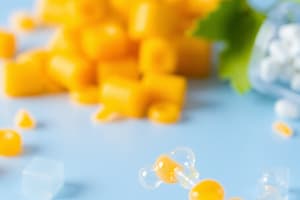Podcast
Questions and Answers
What is one of the primary functions of carbohydrates?
What is one of the primary functions of carbohydrates?
- Provide energy (correct)
- Act as neurotransmitters
- Transport oxygen
- Protect DNA
How are monosaccharides primarily categorized?
How are monosaccharides primarily categorized?
- Simple sugars and Complex carbohydrates
- Disaccharides, Trisaccharides, and Hexoses
- Monosaccharides, Oligosaccharides, and Polysaccharides (correct)
- Triglycerides, Oligosaccharides, and Polysaccharides
Which type of bond forms between monosaccharides during the creation of disaccharides?
Which type of bond forms between monosaccharides during the creation of disaccharides?
- Ionic bond
- Hydrogen bond
- Peptide bond
- Glycosidic bond (correct)
Which of the following is NOT an example of a disaccharide?
Which of the following is NOT an example of a disaccharide?
What functional groups do carbohydrate monomers generally contain?
What functional groups do carbohydrate monomers generally contain?
Which of the following is a characteristic of oligosaccharides?
Which of the following is a characteristic of oligosaccharides?
What is the main storage form of carbohydrates in animals?
What is the main storage form of carbohydrates in animals?
Which of the following polysaccharides is known for being unbranched?
Which of the following polysaccharides is known for being unbranched?
Flashcards
Monosaccharides
Monosaccharides
Simple sugars, basic units of carbohydrates. Examples include glucose, galactose, and fructose.
Disaccharides
Disaccharides
Carbohydrates formed by joining two monosaccharides through a dehydration reaction, forming a glycosidic bond.
Polysaccharides
Polysaccharides
Long chains of monosaccharides linked by glycosidic bonds. Examples include starch and glycogen.
Glycosidic bond
Glycosidic bond
Signup and view all the flashcards
Dehydration reaction
Dehydration reaction
Signup and view all the flashcards
Starch
Starch
Signup and view all the flashcards
Glycogen
Glycogen
Signup and view all the flashcards
Oligosaccharides
Oligosaccharides
Signup and view all the flashcards
Study Notes
Carbohydrates: Structure and Function
- Carbohydrates are vital energy sources and provide structural support within cells.
- Four Primary Functions:
- Providing energy
- Storing energy
- Building macromolecules
- Sparing protein and fat for other uses
- Classification: Monosaccharides, Oligosaccharides, and Polysaccharides.
Monosaccharides
- Simple sugars (e.g., glucose, galactose, fructose)
- Typically 3-7 carbon atoms
- End in "-ose"
- Linked by glycosidic bonds formed via dehydration reactions to create disaccharides and polysaccharides.
Oligosaccharides
- Short chains of monosaccharides (4-10 units)
- Often used as a general term for disaccharides
- Types include:
- Disaccharides (2 monosaccharides)
- Trisaccharides (3 monosaccharides)
- Tetrasaccharides (4 monosaccharides)
- Pentasaccharides (5 monosaccharides)
Disaccharides
- Composed of two monosaccharides.
- Common examples: maltose, lactose, trehalose, sucrose.
- Formation occurs through dehydration reactions (condensation) - a water molecule is removed to create a covalent glycosidic bond.
Polysaccharides
- Long chains of monosaccharides linked by glycosidic bonds.
- High molecular weights (up to 100,000 daltons).
- Important examples: starch, glycogen, cellulose, chitin.
Starch
- Plant storage form of sugar
- Mixture of amylose (unbranched) and amylopectin (highly branched)
Glycogen
- Animal storage form of sugar
- Highly branched structure
Cellulose
- Structural component in plants
- Unbranched structure
- Important for providing structural support.
Other Carbohydrate Information
- Carbohydrates' carbon skeletons are foundational to many organic molecules.
- Carbohydrates are essential in numerous industries (e.g., sugar, starch, paper, textiles, food processing).
- Examples of carbohydrates in nucleic acids include ribose and deoxyribose.
- The basic structure of carbohydrates involves carbon-carbon backbones with C=O and OH functional groups, creating C-O-C linkages.
- Glycogen is typically found in the liver and muscles.
Studying That Suits You
Use AI to generate personalized quizzes and flashcards to suit your learning preferences.
Description
This quiz covers the critical aspects of carbohydrates, including their structure, functions, and classifications. Explore monosaccharides, oligosaccharides, and disaccharides, and learn how these organic compounds support life by providing energy and structural integrity. Test your understanding of the vital roles carbohydrates play in living organisms.




